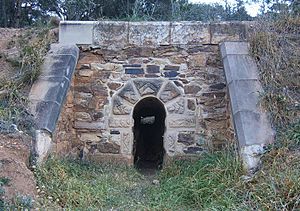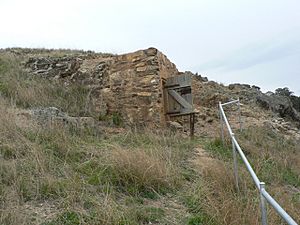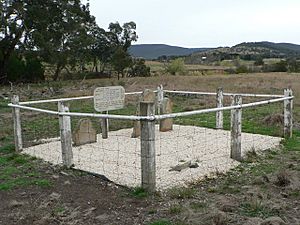Towrang Convict Stockade facts for kids
Quick facts for kids Towrang Convict Stockade |
|
|---|---|

Culvert at the site
|
|
| Location | Old Hume Highway, Towrang, Goulburn Mulwaree Council, New South Wales, Australia |
| Built | 1838–1843 |
| Architect | Possible association with David Lennox |
| Owner | Roads and Traffic Authority, NSW; TOWRANG STOCKADE TRUST |
| Official name: Towrang Convict Stockade, Associated Sites and Road Formations; Towrang Stockade; Great South Road; Towrang Convict Stockade; Tourang; Towrang stockade reserve; Bridge; Culverts; Powder Magazines and Graves | |
| Type | state heritage (archaeological-terrestrial) |
| Designated | 1 February 2013 |
| Reference no. | 1905 |
| Type | Convict labour depot |
| Category | Law Enforcement |
| Builders | Convict Gang |
| Lua error in Module:Location_map at line 420: attempt to index field 'wikibase' (a nil value). | |
The Towrang Convict Stockade is a special historical place in New South Wales, Australia. It's located on the Old Hume Highway near Towrang. This site was a camp where convicts lived and worked. They built parts of the important Great South Road (now the Hume Highway).
The stockade was built between 1838 and 1843. It's now protected as a heritage site. This means it's an important part of Australia's history.
Contents
A Look Back: History of Towrang Stockade
The Towrang Stockade, along with its bridge, culverts, and powder magazine, is near the Wollondilly River. It's about 9.6 kilometers north of Goulburn. This stockade was one of many along the Great South Road. These camps were usually about 16-17 kilometers apart. This distance allowed convicts to walk to their work sites and back each day.
Before Europeans Arrived
Before European settlers came, the Goulburn Plains were home to many Aboriginal groups. These included the Mulwaree, Tarlo, and Wiradjuri peoples. The area was a meeting place for different groups. They hunted, fished, and held important ceremonies here. Evidence of their stone tool making can still be found.
Building the Great South Road
Europeans first saw the Goulburn Plains in 1798. In 1818, explorers like Hamilton Hume and James Meehan explored the area. Soon after, Governor Macquarie ordered the building of the Great South Road. This road was meant to connect Picton to the Goulburn Plains.
Later, Governor Darling became the Governor of New South Wales (1825-1831). He wanted to improve the colony's roads. He started a big road-building program. This was like the main roads in England that spread out from London. The Great South Road was one of these important projects.
Convicts and Road Building
Governor Darling used hundreds of convicts in chain gangs for road work. These gangs were often made up of 30 to 60 men. Some convicts had to work in chains as a punishment. Being freed from chains was a reward for good behavior.
The road gangs were often for convicts who were considered difficult. This was part of a plan to make punishment harsher in the colony. The idea was to make being sent to Australia a strong warning for people in Britain.
Surveyor General Thomas Mitchell later re-surveyed the road to Goulburn. Building the road was slow because they kept finding better routes. The Great South Road didn't reach Yass until the 1850s. Even then, it was still a rough track.
Life at the Stockade
The Towrang Stockade was a major convict camp in southern New South Wales. It operated from about 1838 to 1843. It was known for its strict rules. In 1838, it held 70 men in irons and 21 not in irons. Other reports say it held up to 250 convicts. It was the largest group of convicts in the southern region at that time.
British soldiers guarded the convicts. The stockade had huts for soldiers and their families. There were also huts and small timber cells for the convicts. These huts were likely made of wood and rubble.
Convicts with shorter sentences did lighter work. This included looking after horses or driving bullock teams. Convicts with longer sentences were in the "iron gang." They did the hardest work, like building roads, culverts, and bridges.
The Towrang Stockade closed in 1843. The land was later divided up and sold.
Powder Magazine
The powder magazine was a storage building. It was partly dug into the hillside near the Wollondilly River. It held blasting powder. This powder was used to break up rocks for road building. Part of the entrance was fixed in 1975, but most of it is still original.
Cemetery
Only three headstones remain in the cemetery today. They belong to Private John Moxey (a soldier who died in 1838), Elizabeth Whittacker (died 1841), and Mary Brown (died 1841). It's believed that both soldiers and convicts were buried here.
Bridge and Culverts
Near the stockade site are the Towrang Bridge and seven culverts. Culverts are like small tunnels that allow water to flow under a road. Convicts from the Towrang Stockade likely built these structures.
The famous bridge designer David Lennox might have designed the Towrang Bridge. He designed other important bridges like Lansdowne Bridge. The Towrang Bridge was built around 1836-1839.
What You Can See Today: Description of the Site
The Towrang Stockade site is located along the original Great South Road. It's near the current Hume Highway. The site includes the bridge, seven culverts, the stockade area, and the powder magazine.
The bridge and most culverts are on the south side of the Hume Highway. You can access them from a highway rest area. It's best to view the bridge from a small lookout nearby. Only two of the culverts are easy to reach.
One culvert, the stockade site, powder magazine, and graves are on the north side of the highway. They are spread out over a large area. You can see what looks like old building foundations. The site has signs to help you understand it. The graves are separated from the main site by Towrang Creek.
Some parts of the site have been restored. Work was done on culverts in 1987. More restoration happened on the bridge, culverts, and powder magazine starting in 1989.
The Bridge
The bridge crosses Towrang Creek. It's made of carefully cut sandstone blocks. The year "1839" used to be visible on a central stone, but it has been damaged.
The Culverts
The culverts are west of the bridge. They are mostly made of shale rock. They have sandstone blocks around their arches and corners. Some culverts have been repaired with new blocks.
Powder Magazine and Huts
The powder magazine is partly dug into the hillside. It has stonework made of sandstone and shale. It used to have an arch over its entrance, but now it has a flat stone beam.
Archaeologists have found old hearths (fireplaces) and rubble from the convict huts. They have also found items like uniform buttons, pins, broken dishes, and handmade tools. This helps us learn about daily life at the stockade.
The Monuments
The three remaining graves are in a flat area near the river. They are fenced off for protection. The headstones are made of sandstone. They face east.
Here's what the headstones say:
- One is for Mary Brown, who died on June 25, 1841.
- Another is for Elizabeth Whiticker, who died on June 9, 1841, aged 33. The bottom part of this stone is missing.
- The third is for John Moxey, a private soldier. He died on November 13, 1838, aged 38. He had served for 22 years. His comrades put up the stone to show their respect. It has a poem that says: "Remember me as you pass by. As you are now son once was I. As I am now so you must be. Prepair (sic) for death to follow me."
Condition of the Site
Overall, the site is in fair to good condition. However, some things have caused damage over time:
- Telecommunication cables have been laid through parts of the site.
- The grave markers have been damaged by vandalism.
- Old archaeological remains are eroding away.
- Artifacts exposed on the surface can be lost.
Despite these issues, the site still holds a lot of its original historical value.
Why Towrang Stockade is Important: Heritage Listing
The Towrang Stockade and its related sites are very important. They are listed on the New South Wales State Heritage Register. This means they are recognized as a significant part of the state's history.
The site is special because it's a rare, mostly untouched convict stockade. It shows how Governor Darling used road work as a punishment for convicts. It also gives us a look into convict life and early road building in New South Wales. The Towrang Stockade had the largest number of convicts in southern NSW during its time.
Historical Importance
The Towrang Stockade is important because it's linked to Governor Darling's "Great Roads" plan. This plan helped expand the colony and improve its economy. The site also shows how communication improved between Sydney and the southern settlements.
It's also a physical reminder of the harshness of convict life. The large number of convicts and strict rules at Towrang show how the British government wanted harsher punishments. This was to make being sent to Australia a strong deterrent.
Design and Building Skills
The bridge, culverts, and road alignment are like landmarks. They show the amazing skill of the convict laborers. The stone work is very well done. They help us understand how roads were built in the early days.
Learning from the Past
The stockade and road formations can teach us a lot. They show us the building technologies used during the convict era. They also have the potential to reveal more about the cultural history of the region through archaeological digs.
A Rare Example
The combination of the bridge, road, culverts, and stockade area is rare. It's a unique example of a convict settlement and industry. The stockade is special because it's still partly intact and hasn't been changed by modern development.
A Typical Example
The culverts and bridge are excellent examples of their construction style. The stockade site is a good example of the many camps built for convict road gangs. These camps were essential for building the roads south from Sydney.





